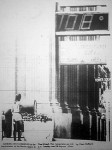 The July 1980 United States heat wave was a period of intense heat and drought that wreaked havoc on much of the Midwestern United States and Southern Plains throughout the summer of 1980. It is among the most devastating natural disasters in terms of deaths and destruction in U.S. history, claiming at least 1,700 lives and because of the massive drought, agricultural damage reached $20 billion dollars. It is among the billion-dollar weather disasters listed by the National Oceanic and Atmospheric Administration.
The July 1980 United States heat wave was a period of intense heat and drought that wreaked havoc on much of the Midwestern United States and Southern Plains throughout the summer of 1980. It is among the most devastating natural disasters in terms of deaths and destruction in U.S. history, claiming at least 1,700 lives and because of the massive drought, agricultural damage reached $20 billion dollars. It is among the billion-dollar weather disasters listed by the National Oceanic and Atmospheric Administration.
The heat wave began in June when a strong high pressure ridge began to build in the central and southern United States allowing temperatures to soar to 90 °F almost every day from June to September. The high pressure system also acted as a cap on the atmosphere inhibiting the development of thunderstorm activity leading to exceptionally severe drought conditions. The heat wave broke only when decaying Hurricane Allen disrupted the prevailing weather pattern.
The drought and heat wave conditions led many Midwestern cities to experience record heat. In Kansas City, Missouri, the high temperature was below 90 only twice and soared above the century mark (100 °F) for 17 days straight and in Memphis, Tennessee, the temperature reached an all-time high of 108 °F on July 13, 1980, part of a 15-day stretch of temperatures above 100 °F that lasted from July 6–20, 1980.
On the local front, here in Marion, the Marion Daily Republican tracked the temperatures to as high as 108-109 degrees on the Bank of Marion sign on the square. Local weather observers, Mr. and Mrs. Anthony Mignone north of Marion tracked the temperature to as high as 105 degrees on July 17, 1980, explaining that the differences had to do with the height that the temperatures were taken off of the ground.
Governor James R. Thompson, asked state officials to keep senior citizen centers to remain open longer to provide relief for the state’s elderly. Eighteen deaths were reported in the Southern Illinois area.
Crops were damaged and livestock was stressed, in addition to humans, who had no recourse from the perpetual blast of heat even in the evening when temperatures only dropped into the 90’s.
Along with the sweltering heat, numerous storms and high winds accompanied the blast.
In Marion, a damaging windstorm on Sunday, June 29th was followed, like a one, two punch, on Wednesday, July 2nd , by another damaging windstorm, which was reported to be, ten times the strength of the first causing great damage throughout Southern Illinois. In Marion, extended power and phone outages, tree, home and business damage marked the storm and caused a clean-up operation that went on for weeks following the event.
On July 22nd 1980, an 8/10ths on an inch rain, caused by Hurricane Allen, was the first in Marion since the disastrous windstorm of July 2nd and brought relief from 20 days of heat that saw continuous temperatures exceeding 100 degrees daily.
The rain allowed an almost instant cooling to a temperature of 74 degrees at 8 a.m. and broke the back of the heat wave that had stalked the entire country and was reported to be responsible for at least five deaths among the elderly in Williamson County.
(Extracted from Marion Daily Republican articles June through July 1980; Wikipedia; compiled by Sam Lattuca on 12/20/2013)
